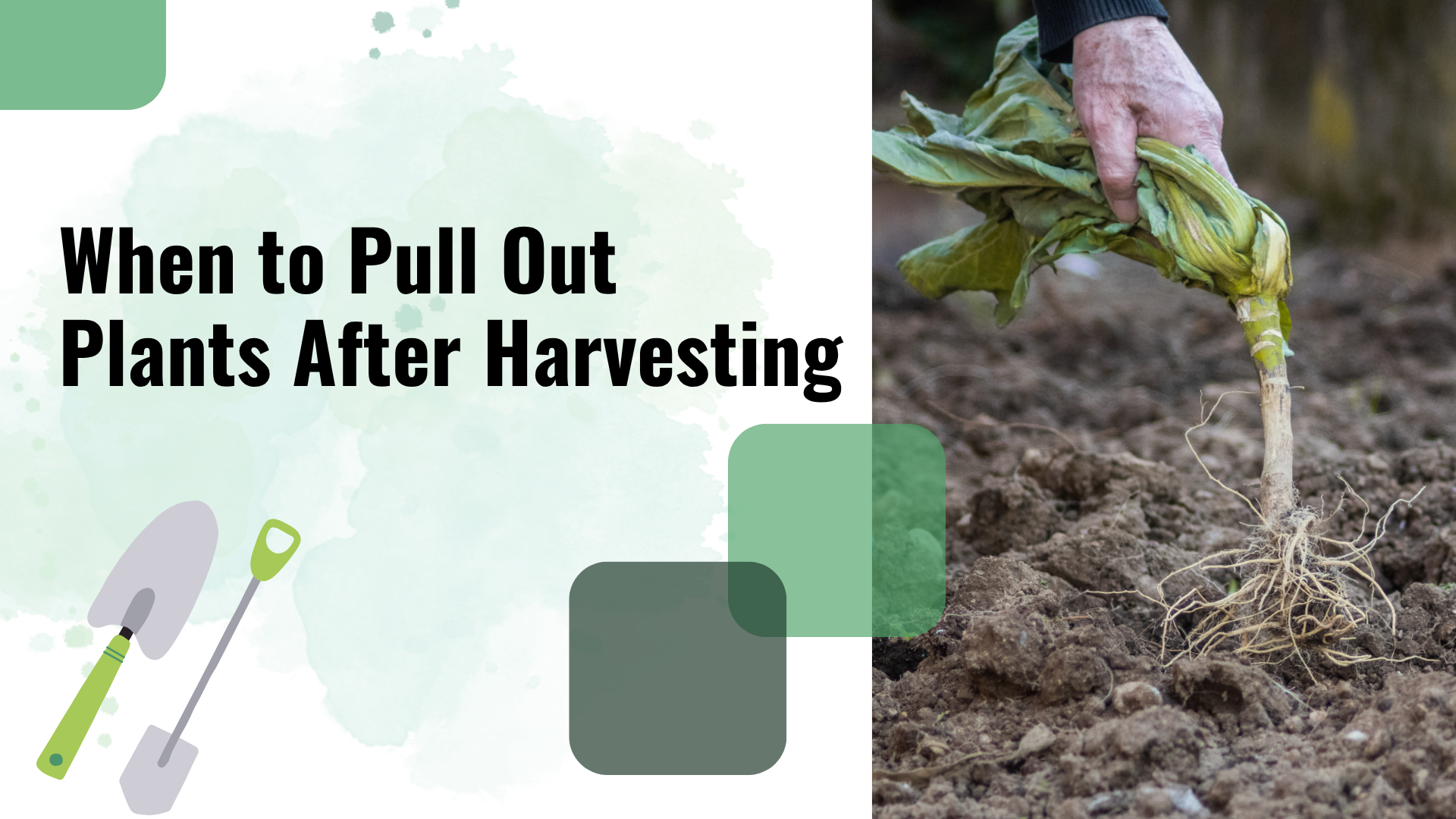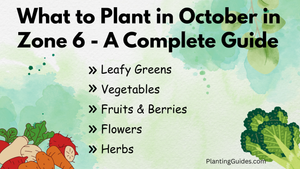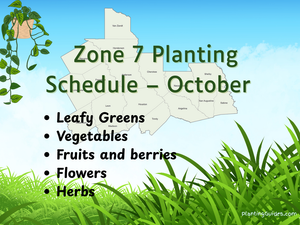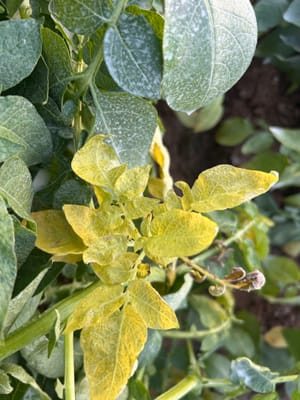When to Pull Out Plants After Harvesting - A Complete Guide
By Parvez Akhtar Pasha | Oct 19, 2025

I think this is one of the most asked questions by gardeners. They often ask things like, 'My tomato plant has no more tomatoes, should I pull it out?' or 'My lettuce turned bitter, do I leave it or remove it?'
Trust me, this is really a confusing task. I know exactly what you are thinking. I’ve gone through the same stage you are in right now. After the harvest, I was just looking at the plants, scratching my head, and thinking, 'What now? Should I pull them out, leave them, or just wait and see?'
You know what the truth is, the best answer really depends on the type of plant, its life cycle, and even your garden goals anyway.
If you pull your plants too soon, you waste potential harvests. If you wait too long, you get pests, diseases, or a messy garden.
Annual Vegetables
As we all know, annual vegetables finish their whole life cycle in just one growing season. They sprout, grow, make food, produce seeds, and then die.
If you pull them out at the right time, your garden soil stays healthy and ready for the next crop. And also, old plants can attract pests and diseases if left too long.
We all know that garden waste can be composted to improve the soil, but never compost diseased plants—they could spread infections and harm your future crops.
| Crop | When to Pull | Signs | Soil / Compost Tips After Pulling |
|---|---|---|---|
| Lettuce (Leaf / Romaine / Butterhead) | When leaves taste bitter or flower appears | Flower stalk, bitter leaves | Cut at soil level; compost leaves; roots slowly enrich soil |
| Spinach | When it starts flowering in hot weather | Long stems, narrow bitter leaves | Pull whole plant; compost leaves; roots can enrich soil |
| Arugula / Rocket | When leaves taste bitter or plant bolts | Flower stalk, bitter leaves | Pull entire plant; compost; leave roots to enrich soil |
| Mustard Greens | When leaves turn bitter or flower appears | Flower stalk, bitter leaves | Pull entire plant; compost; roots improve soil fertility |
| Kale | When leaves toughen or flower appears | Tall flower stem, tough leaves | Pull entire plant; compost leaves; leave roots if soil enrichment needed |
| Swiss Chard | When outer leaves yellow or bolt | Yellowing leaves, tall stalks | Pull older leaves; compost; roots can stay for multiple harvests if healthy |
| Bok Choy / Pak Choi | When leaves yellow or flower appears | Flower stalk, yellow leaves | Pull whole plant; compost; roots slowly enrich soil |
| Mizuna | When leaves taste bitter or plant bolts | Flower stalk, bitter leaves | Pull entire plant; compost; leave roots to enrich soil |
| Tatsoi | When leaves toughen or bolt | Flower stalk, tough leaves | Pull entire plant; compost; roots improve soil |
| Collard Greens | When leaves toughen or flower appears | Flower stalk, tough leaves | Pull entire plant; compost; roots can improve soil |
| Radicchio / Chicory | When leaves taste bitter or heads form | Flower stalk, bitter leaves | Pull entire plant; compost; roots slowly enrich soil |
| Endive / Escarole | When leaves toughen or bolt | Flower stalk, bitter leaves | Pull entire plant; compost; roots improve soil |
| Radish | When roots are full size or taste hot | Roots harden, leaves yellow | Pull entire plant; compost tops; harvest roots promptly |
| Carrots | When roots reach mature size | Tops yellow, roots firm | Pull entire plant; compost tops; harvest roots promptly |
| Beets | When roots are firm and leaves yellow | Yellowing leaves, roots firm | Pull entire plant; compost leaves; harvest roots promptly |
| Turnips | When roots are full size | Yellowing leaves, firm roots | Pull whole plant; compost leaves; harvest roots promptly |
| Kohlrabi | When bulbs reach desired size | Bulbs firm, leaves yellowing | Pull plant; compost leaves; harvest bulbs promptly |
| Cabbage | After heads form and are firm | Large firm heads, outer leaves yellow | Pull plant; compost outer leaves; avoid diseased parts |
| Cauliflower | When curds are firm and compact | Curds firm, outer leaves yellowing | Pull plant; compost leaves; remove diseased parts |
| Broccoli | When main head is fully formed | Large central head, small flowers appear | Pull plant; compost leaves; side shoots may produce more |
If the leaves turn yellow, wilt, or become diseased, or if the plant feels soft and weak or sends up flower stalks (called bolting), it's time to pull it out—even if the calendar date hasn't come yet.
If you see any signs of disease in your plant, remove the plant immediately, especially for fungal stuff like powdery mildew, blight, or rust.
I don't think we need to discuss or make a separate table for root vegetables like carrots, radishes, or beets, because we usually pull out the entire plant when we harvest them anyway.
Perennial Vegetables
We all know that very well, perennial vegetables live for many years, they come back year after year from the same roots. You don't need to pull them out unless they're diseased, damaged, or you want to replace them.
DON'T pull out your perennial vegetables (not only vegetables all kind of plants), just cut back/ prune them.
If you prune your perennial vegetables properly, protect them during winter, and manage their flowers, they will stay productive and healthy for a long time.
| Plant | Action | When to Cut/Remove | Care Tips |
|---|---|---|---|
| Asparagus | Cut old stalks to soil level | After first hard frost or when ferns yellow/brown | Mulch crowns for winter. Avoid harvesting young shoots first 2–3 years. |
| Rhubarb | Remove stalks at soil level | Late summer to early fall | Don’t harvest first 2 years. Mulch in winter. Remove flower stalks for bigger stalks. |
| Artichokes | Cut stems down to ~6 inches | After flowering ends (late fall) | Mulch crowns in cold climates. Avoid cutting crown. Remove flower stalks. |
| Jerusalem Artichokes (Sunchokes) | Dig tubers, leaving some in soil | After frost or tuber maturity | Never remove all tubers; leave some for next season. Mulch for winter protection. |
| Horseradish | Cut leaves if needed | Late fall | Roots left in ground; dig for harvest sparingly. |
| Globe Artichoke | Cut spent flower stems | Late fall | Protect crowns with mulch in cold zones. |
| Egyptian Walking Onion | Harvest bulbs and cut tops | After foliage dies | Bulbs multiply; leave some in ground. |
| Sea Kale | Cut old leaves to ground | Late fall | Mulch crowns in winter; young shoots edible in spring. |
| Good King Henry | Cut old stems | Fall | Edible shoots in spring; perennial spinach substitute. |
| Lovage | Cut stems to ground | After first frost | Can divide clumps every few years. |
| Sorrel | Trim leaves | Late fall or after frost | Protect crowns with mulch; leaves edible through mild winters. |
| Welsh / Perennial Onion | Cut leaves to soil | Late fall | Leaves regrow in spring. Divide clumps every 3–4 years. |
| Cardoon | Cut old leaves | After first frost | Related to artichoke; mulch crowns in winter. |
| Fennel (Perennial varieties) | Cut stalks | After flowering ends | Protect crowns in frost-prone areas. |
| Ramps (Wild Leek) | Leave leaves or trim lightly | Late summer/fall | Overharvesting kills plant; leave bulbs for next season. |
| Egyptian Onion | Cut back tops | Late fall | Plant offsets remain for next season. |
Always trim the stems, but don’t pull out the roots or main part of the plant unless it's diseased.
You should always add mulch around the base in late fall to keep it safe from frost.
Fruiting Vegetables
As per my gardening experience, fruiting vegetables keep producing for a long time and will continue until frost or disease stops them. I have found that pulling them out at the right time is important to prevent pests, diseases, and to free up space for new plants.
You should immediately pull and destroy the plants that are showing blight, bacterial spots, or powdery mildew. Do NOT compost diseased plants—seriously, don't!
| Crop | When to Pull | Signs | Helpful Info |
|---|---|---|---|
| Tomatoes (Indeterminate) | After frost kills foliage OR flowering stops | Blackened leaves, no new buds or flowers | Green tomatoes can be picked and ripened indoors; healthy cuttings can grow indoors for next season |
| Tomatoes (Determinate) | After final fruit ripens | Bush stops producing, foliage yellowing | Good for canning; won't grow back after harvest |
| Bell Peppers | After frost OR when plant stops flowering | Leaves limp, blackened, or curling; no new buds | In zones 9–11, peppers can overwinter as perennials indoors or in protected areas |
| Chili Peppers | After frost OR no flowers/fruits forming | Branches dry or woody, declining leaf health | Can be left on plant in mild climates for late harvest |
| Eggplants | When flowering and fruiting stop OR frost kills plant | Yellowing leaves, woody stems, small seedy fruits | In mild climates, prune and bring indoors to keep the harvest going. |
| Okra | Pull when pods turn woody and flowering stops | Fibrous pods, sparse growth, brown leaves | Frequent picking keeps pods tender; plant cycle ends naturally after first frost |
| Cucumbers | Pull when flowering/fruiting stops OR mildew overtakes | Brown leaves, few/no flowers, declining vines | Small mildew can be cut off to keep harvesting; severe disease → pull immediately |
| Summer Squash (Zucchini, Yellow Squash) | Pull when vines collapse or flowering ceases | Wilted stems, no new flowers or fruits | Vine borer infestation → pull immediately to prevent spread |
| Pumpkins | Pull after final harvest and vines dry | Brown/yellow vines, brittle stems, no flowers | Cure harvested fruits 1–2 weeks before storing; remove diseased vines from garden |
| Melons (Cantaloupe, Watermelon) | Pull after final fruit harvest & vines die | Hollow stems, dry leaves, fruits fully ripe | Watermelons must ripen on vine; cantaloupe can ripen indoors if picked a bit early |
| Tomatoes (Cherry & Grape varieties) | Pull after frost OR flowers stop | Small fruits stop forming, leaves yellow | Regular picking extends the season; cuttings can overwinter indoors. |
I always pull out plants only when they have completely stopped flowering or fruiting, or if frost or disease has killed them.
In frost-free areas or indoor conditions, many fruiting vegetables like tomatoes, peppers, and eggplants can be overwintered so they start growing earlier next season.
Herbs
If your herbs stop flowering or their leaves lose smell, it's time to pull them out. If you leave them too long, they can attract pests, drop seeds, or get fungus.
As I said earlier, you should only remove the perennial plants if they're sick, badly damaged, or if you plan to plant something new in their place.
| Herb | When to Pull | Signs | Helpful Info |
|---|---|---|---|
| Basil | Pull at the end of summer or before first frost | Leaves turn dull, flowers form, or stems woody | Pinch off flowers early to extend life; once frost hits, it won’t recover |
| Cilantro (Coriander) | Pull when it bolts (sends up tall flower stalks) | Leaves become thin and bitter | You can let it self-seed for next season if you leave some seed heads |
| Dill | Pull after seeds mature and brown | Feathery leaves dry out; stalk turns yellow | You can leave a few plants to self-seed naturally for next season |
| Parsley (biennial but treated as annual) | Pull after second year or once leaves turn yellow after flowering | Flower stalk appears; leaf flavor declines | In mild winters, it may survive as a short-lived biennial |
| Chervil | Pull once plants start flowering or yellowing | Leaves lose aroma | Prefers cool weather — bolts fast in heat, so succession planting helps |
| Borage | Pull after flowering ends | Leaves become coarse and wilt | Self-seeds easily; can reappear next season on its own |
| Summer Savory | Pull when flowering ends | Stems toughen and flavor fades | Do not confuse with winter savory (a perennial) |
| Anise | Pull after seed heads mature and dry | Leaves wilt; seed pods turn brown | You can cut stems and hang upside down to dry for seeds |
| Chamomile (German) | Pull when flowering is done and stems dry | Flowers fade and plant browns | German chamomile is annual; Roman chamomile is perennial |
| Cress (Garden or Curly) | Pull after harvesting leaves before flowering | Leaves get bitter when bolting starts | Grows fast, can reseed easily |
| Fenugreek (Methi) | Pull when pods turn brown and dry | Leaves yellow, growth stops | Great green manure if roots left to decompose |
Pull all annual herbs (such as basil, cilantro, dill, and borage) immediately after they start flowering or producing seeds. If left, they will become bitter.
Flowers-When to Pull or Cut
The right time to pull or cut flower plants, not only flowers but actually all kinds of plants, depends on what kind of plants they are — annuals, perennials, bulbs, or those that leave seed heads.
If you follow the table below, you will know exactly what action to take, cut or pull, for each type of flower plant.
| Type of Flower Plant | Action Required |
|---|---|
| Annuals | Pull out completely after they finish blooming |
| Perennials | Cut back after the foliage dies naturally in fall |
| Bulbous Flowers (e.g., tulips, daffodils) | Cut back foliage only when leaves turn yellow and dry |
| Seed-head / Wildlife-friendly Flowers | Leave standing in winter, cut back / prune in early spring |
If you take the right action at the right time, it will help your flowers grow back stronger next season, keep your garden healthy, and provide food and shelter for birds and other wildlife.
When to Pull Out Annual Flowers
| Flower Name | When to Pull out | Signs | Useful Info |
|---|---|---|---|
| Zinnia | After last blooms & stems dry | Brown, brittle stems | Save seeds for next season |
| Marigold | After flowering ends | Yellowing leaves, no new buds | Some varieties self-seed if left |
| Petunia | When flowers stop producing | Drooping or wilted leaves | Light trimming can encourage late blooms in frost-free areas |
| Calendula | After blooms fade | Brown petals, no new buds | Leaves can be used in herbal remedies before pulling |
| Cosmos | After flowering stops | Dry stems, no flowers | Leave some for seeds if desired |
| Nasturtium | After flowering ends | Leaves yellowing, no new blooms | Edible leaves; can be used in salads before removal |
| Impatiens | End of blooming season | Wilting, yellowing leaves | Remove to prevent fungal issues in shaded areas |
| Sweet Alyssum | After flowering | Flowers fading, plants look leggy | Can be cut back lightly to encourage more blooms |
| Snapdragons | After flowering | Leaves yellowing, stems fading | Some can regrow if trimmed before frost |
| Sunflower | After blooms and seeds mature | Drooping flower heads, leaves dry | Collect seeds if desired |
| Ageratum | After flowering | Flowers brown or wilting | Cut back to encourage new blooms |
| Lobelia | After flowering | Flowers fading, leggy growth | Can be cut back to encourage late blooms |
| Sweet Pea | After flowering | Stems turning woody, leaves fading | Save seeds from pods for next season |
| Salvia | After blooms fade | Flowers gone, leaves wilting | Some types may rebloom if lightly cut back |
| Morning Glory | Pull out after flowering | Vines yellowing or dying back | Leave for seeds if desired |
| Portulaca | After flowering | Flowers faded, leaves wilting | Can regrow in warm weather if trimmed |
I always remove annual flowers as soon as their blooms fade so they don't grow tall and messy or attract unwanted bugs like aphids and spider mites.
I don't think there's any need to make separate tables for each type of flower. From the table I have provided earlier, right above this table, you can easily understand when to pull, cut, or prune other flower types too. That table pretty much covers them all.







